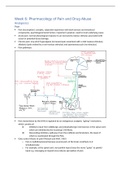Week 6: Pharmacology of Pain and Drug Abuse
Analgesics
Pain
Pain (nociception): complex, subjective experience with both sensory and emotional
components, psychological/social factors, important symptom, need to treat underlying cause
Acute pain: normal physiological response to an excessively noxious stimulus associated with
actual or potential tissue damage.
Chronic pain: may elicit hyperalgesia (increased pain associated with a mild noxious stimulus),
allodynia (pain evoked by a non-noxious stimulus) and spontaneous pain (no stimulus).
Pain pathways:
Pain transmission by the DHN is regulated by an endogenous analgesic “gating” mechanism,
which consists of:
(i) Inhibitory input from GABAergic and enkephalinergic interneurons in the spinal cord,
which are inhibited by the incoming C/Aδ fibres.
(ii) Descending inhibitory pathways from the midbrain and brainstem, the input of
which is coordinated through the PAG.
Gate control theory of pain (Melzack and Wall, 1965)
o Pain is multidimensional because several parts of the brain contribute to it
simultaneously.
o For example, at the spinal cord, non-painful input closes the nerve “gates” to painful
input e.g. massaging an injured area reduces perception of pain.
,Approaching pain management
1. Assess severity: quantify pain on scale (1-10)
2. Introduce painkillers step-wise (WHO analgesic ladder)
3.
4. Give regular painkillers for ongoing pain
5. Be aware of potential side effects
Inflammation and immune response
Inflammation: loss of function, pain, swelling, redness, heat
o Caused by action of prostanoids (prostaglandins, thromboxanes, prostacyclins)
Innate acute inflammatory reaction:
o Vascular events: vasodilation, increased permeability of postcapillary venules, exudation
of fluid.
o Cellular events: neutrophils, monocytes, lymphocytes, natural killer cells accumulate and
are activated, ingest microorganisms, or kill infected cells, release mediators. Tissue cells
include vascular endothelial cells, mast cells and macrophages.
Adaptive immune reaction:
o Induction phase
o Effector phase: antibody-mediated and cell-mediated component
, Bradykinin:
o Non-peptide by-product of plasma a-globulin
o Actions in inflammation:
vasodilation (mediated by release of NO and PGI 2)
increased vascular permeability
stimulation of pain nerve endings (potentiated by PGs)
Histamine:
o Released from mast cells by complement C3a or in type 1 hypersensitivity by an antigen-
antibody reaction on the cell surface.
Nitric oxide (NO):
o Most inflammatory cells express the inducible form of NO synthase when activated by
cytokines.
o NO dilates blood vessels, increases vascular permeability and stimulates PG release.
Cytokines:
o Peptide mediators
o Interleukins e.g. IL-2, TNFa, IL-5
o Chemokines
o Colony-stimulating factors




